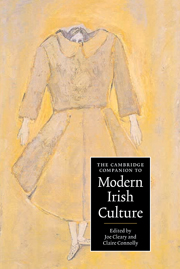Book contents
- Frontmatter
- 1 Introduction: Ireland and modernity
- Part I Cultural politics
- Part II Cultural practices and cultural forms
- 9 Modernism and the Irish revival
- 10 Poetry in Ireland
- 11 Irish sport
- 12 Projecting the nation: cinema and culture
- 13 Folk culture
- 14 Irish prose fiction
- 15 Irish music
- 16 Modern architecture and national identity in Ireland
- 17 The visual arts in Ireland
- 18 Irish theatre
- Index
12 - Projecting the nation: cinema and culture
from Part II - Cultural practices and cultural forms
Published online by Cambridge University Press: 28 May 2006
- Frontmatter
- 1 Introduction: Ireland and modernity
- Part I Cultural politics
- Part II Cultural practices and cultural forms
- 9 Modernism and the Irish revival
- 10 Poetry in Ireland
- 11 Irish sport
- 12 Projecting the nation: cinema and culture
- 13 Folk culture
- 14 Irish prose fiction
- 15 Irish music
- 16 Modern architecture and national identity in Ireland
- 17 The visual arts in Ireland
- 18 Irish theatre
- Index
Summary
From the earliest period, cinema in Ireland has contended with two apparently conflicting forces: the 'esperanto of the eye' promulgated by the globalising drive of Hollywood, and the localising lens adopted by the Irish Literary Revival. Part of the cultural power of Hollywood in its formative decades lay in its appeal, as a cheap form of entertainment, to the working class and immigrant populations rapidly expanding in American cities at the turn of the century. To facilitate cross-cultural markets, story-lines, narrative forms and visual styles were devised that addressed spectators not as 'Irish', 'Italians' or 'Jews' but at the most general, human interest level - shorthand for the individualism and universal aspirations of the American way of life. Notwithstanding its crass commercialism, the movie industry also performed a powerful civic function: by divesting viewers of their ethnicity or inherited loyalties, or at least making them redundant on entering a film theatre, it promoted the assimilation of widely divergent cultural minorities into the white American mainstream. It was not entirely coincidental that D.W. Griffith called his landmark film The Birth of a Nation (1915) - though its white supremacist vision and replaying of the civil war also betrayed some of the underlying narratives of that nation.
But while cinema was establishing a commodified public sphere in the United States – what Robert Sklar refers to as ‘movie-made America’ – theatre and literature were spearheading a national renaissance of a different kind in Ireland. As if emphasising the very cultural ties endangered by Hollywood, the Irish literary movement looked to the past, the vernacular and the local to stage its version of the nation. It would be a mistake, however, to see this solely in terms of the backward look of romanticism.
- Type
- Chapter
- Information
- The Cambridge Companion to Modern Irish Culture , pp. 206 - 224Publisher: Cambridge University PressPrint publication year: 2005
- 4
- Cited by

